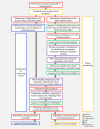Ethical challenges in genetic research among Philippine Indigenous Peoples: Insights from fieldwork in Zamboanga and the Sulu Archipelago
- PMID: 36324515
- PMCID: PMC9619191
- DOI: 10.3389/fgene.2022.901515
Ethical challenges in genetic research among Philippine Indigenous Peoples: Insights from fieldwork in Zamboanga and the Sulu Archipelago
Abstract
The Philippines, with the recent discovery of an archaic hominin in Luzon and an extensive ethnolinguistic diversity of more than 100 Indigenous peoples, is crucial to understanding human evolution and population history in Island Southeast Asia. Advances in DNA sequencing technologies enable the rapid generation of genomic data to robustly address questions about origins, relatedness, and population movements. With the increased genetic sampling in the country, especially by international scientists, it is vital to revisit ethical rules and guidelines relevant to conducting research among Indigenous peoples. Our team led fieldwork expeditions between 2019 and February 2020 in Zamboanga and the Sulu Archipelago, a chain of islands connecting the Mindanao and Borneo landmasses. The trips concluded with a collection of 2,149 DNA samples from 104 field sites. We present our fieldwork experience among the mostly sea-oriented Sama-Bajaw and Tausug-speaking communities and propose recommendations to address the ethical challenges of conducting such research. This work contributes toward building an enabling research environment in the Philippines that respects the rights and autonomy of Indigenous peoples, who are the rightful owners of their DNA and all genetic information contained therein.
Keywords: Philippine Indigenous peoples; Sama; Sulu Archipelago; Tausug; Zamboanga; population genetics; research ethics.
Copyright © 2022 Rodriguez, Cuales, Herrera, Zubiri, Muallil, Ishmael, Jimenez, Stoneking and De Ungria.
Conflict of interest statement
The authors declare that the research was conducted in the absence of any commercial or financial relationships that could be construed as a potential conflict of interest.
Figures



References
-
- Barrows D. P. (1910). The Negrito and allied types in the Philippines. Am. Anthropol. 12, 358–376. 10.1525/aa.1910.12.3.02a00020 - DOI
-
- Bellina B., Blench R., Galipaud J. C. (Editors) (2021). Sea nomads of Southeast Asia from the past to the present (Singapore: NUS Press; ).
-
- Bellwood P. (1997). Prehistory of the indo-Malaysian archipelago. United States: Univ. Hawai'i Press.
-
- Blust R. (2007). The linguistic position of Sama-Bajaw. Stud. Philipp. Lang. Cult. 15, 73–114.
LinkOut - more resources
Full Text Sources

